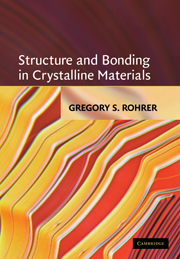Book contents
- Frontmatter
- Contents
- Preface
- 1 Introduction
- 2 Basic Structural Concepts
- 3 Symmetry in Crystal Structures
- 4 Crystal Structures
- 5 Diffraction
- 6 Secondary Bonding
- 7 Ionic Bonding
- 8 Metallic Bonding
- 9 Covalent Bonding
- 10 Models for Predicting Phase Stability and Structure
- Appendix 1A Crystal and univalent radii
- Appendix 2A Computing distances using the metric tensor
- Appendix 2B Computing unit cell volumes
- Appendix 2C Computing interplanar spacings
- Appendix 3A The 230 space groups
- Appendix 3B Selected crystal structure data
- Appendix 5A Introduction to Fourier series
- Appendix 5B Coefficients for atomic scattering factors
- Appendix 7A Evaluation of the Madelung constant
- Appendix 7B Ionic radii for halides and chalcogenides
- Appendix 7C Pauling electronegativities
- Appendix 9A Cohesive energies and band gap data
- Appendix 9B Atomic orbitals and the electronic structure of the atom
- Index
4 - Crystal Structures
Published online by Cambridge University Press: 23 February 2011
- Frontmatter
- Contents
- Preface
- 1 Introduction
- 2 Basic Structural Concepts
- 3 Symmetry in Crystal Structures
- 4 Crystal Structures
- 5 Diffraction
- 6 Secondary Bonding
- 7 Ionic Bonding
- 8 Metallic Bonding
- 9 Covalent Bonding
- 10 Models for Predicting Phase Stability and Structure
- Appendix 1A Crystal and univalent radii
- Appendix 2A Computing distances using the metric tensor
- Appendix 2B Computing unit cell volumes
- Appendix 2C Computing interplanar spacings
- Appendix 3A The 230 space groups
- Appendix 3B Selected crystal structure data
- Appendix 5A Introduction to Fourier series
- Appendix 5B Coefficients for atomic scattering factors
- Appendix 7A Evaluation of the Madelung constant
- Appendix 7B Ionic radii for halides and chalcogenides
- Appendix 7C Pauling electronegativities
- Appendix 9A Cohesive energies and band gap data
- Appendix 9B Atomic orbitals and the electronic structure of the atom
- Index
Summary
Introduction
The most unambiguous way to describe the structure of a crystal is to specify the chemical composition, the space group, the cell dimensions, the number of formula units per cell, and the coordinates of the crystallographically distinct atoms. This is the symmetry based method described in Chapter 3 and many structures are described this way in Appendix 3B. While we will continue to use this method, we should also recognize its shortcomings. First, based on tabulated data, it is difficult to understand the geometric arrangement of the atoms without taking the time to draw a sketch. Second, the conventional information does not provide the context necessary for the comparison of different structures.
The primary objective of this chapter is to describe an alternative and less rigid method for the description of crystal structures. The basic idea is to assume that all of the atoms in the cell are situated either at the sites of a prototypical close packed structure or at one of a few well defined interstitial sites. Structures are differentiated by the pattern in which these sites are occupied. While this method lacks specificity, it provides an immediate understanding of the geometric arrangement of atoms and a context for the comparison of different structures. The advantage of this method is that by understanding a few geometric principles, it is possible to describe a vast number of crystal structures. A secondary objective of this chapter is to survey important prototype crystal structures.
- Type
- Chapter
- Information
- Structure and Bonding in Crystalline Materials , pp. 135 - 204Publisher: Cambridge University PressPrint publication year: 2001
- 1
- Cited by

